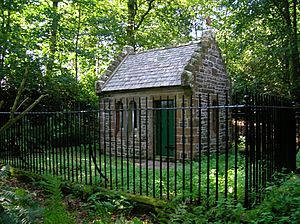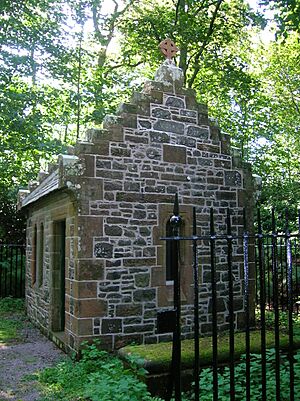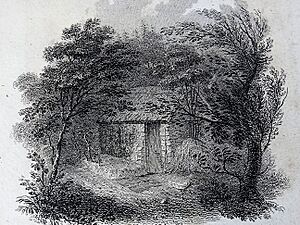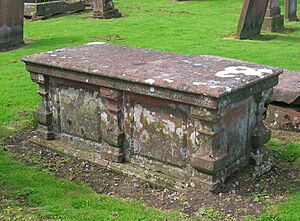The Hermitage, Friars Carse facts for kids
Quick facts for kids The Hermitage |
|
|---|---|

Robert Burns' Hermitage at the Friars Carse
|
|
| Type | Hermitage Folly |
| Location | Auldgirth, Dumfries, Scotland UK grid reference NX9253884593 |
| Built | 18th century and rebuilt in 1874 |
| Built by | Robert Riddell, later rebuilt by Thomas Nelson |
| Owner | Post Office Fellowship of Remembrance Ltd. |
|
Listed Building – Category B
|
|
| Official name: Friars Carse Burns Hermitage | |
| Designated | 26 June 1986 |
| Reference no. | LB4233 |
| Lua error in Module:Location_map at line 420: attempt to index field 'wikibase' (a nil value). | |
The Hermitage is a special little building in Auldgirth, Scotland. It was first built as a "folly," which is a building made just for fun or decoration, often in a garden or park. This Hermitage is famous because of its link to the well-known Scottish poet, Robert Burns.
Burns was good friends with Captain Robert Riddell, who owned the land. Riddell let Burns use this quiet, peaceful spot to write his poems. Burns even carved some lines into a window pane at the Hermitage after his friend Riddell passed away. The first Hermitage building eventually became old and broken. It was rebuilt in 1874 and then fixed up again more recently in 2009.
Contents
The Hermitage Building: Past and Present
Captain Robert Riddell built the first Hermitage, a small summer house, in a quiet part of his estate. It was designed to look like a medieval "anchorite's cell." An anchorite was a person in old times who lived alone for religious reasons.
Robert Burns loved using this peaceful building for writing his poetry. He even had a key to a gate that led to it. Burns and Riddell sometimes spent time there together.
What Happened to the First Building?
Sadly, Captain Riddell died quite young in 1794. After his death, the Hermitage was not looked after very well. By 1803, farm animals were even using it!
In 1805, some repairs were made, and a bay tree was planted nearby to remember Robert Burns. However, by 1810, the building was broken down again. The floor was covered in straw, trees were damaged, and the special window pane with Burns's writing was gone.
The Rebuilt Hermitage
The original building no longer exists. However, in 1874, a man named Mr. Thomas Nelson built a new Hermitage on the same spot. This new building looks different from the first one.
When someone visited in 1879, they saw a statue of a monk inside the building. The Hermitage was restored again in 2009. Today, it has a sign that tells its history. The Hermitage is on the private grounds of the Friars Carse Hotel. It is also a "Category B listed building," which means it's an important historical building.
Robert Burns and His Poetry
Robert Burns wrote some of his famous poems while visiting the Hermitage. These poems helped make his friendship with Captain Riddell even stronger.
Poems Written at the Hermitage
By June 1788, Robert Burns had written "Verses in Friars' Carse Hermitage." He later added more to these poems.
Burns's Special Window Carvings
Robert Burns used a special "diamond point pen" to carve lines into the window pane of the first Hermitage. He wrote these words to remember his friend, Robert Riddell:
|
Thou whom chance may hither lead, Life is but a day at most, |
The original window pane was saved and is now at the Ellisland Farm Museum. When the new Hermitage was built in 1874, the same lines were carved onto its window. However, that window is now in the main mansion house, and the Hermitage windows today do not have any writing on them.
The second window of the 1874 building had another verse carved on it:
|
To Riddel, much lamented man, |
See also
- Robert Burns World Federation
- Burns Clubs




